

536. $150
Briggs “Rotary Unknown No. 3”, ca. 1875. The majority of these novelty clocks were made
in the 1870’s by the E.N. Welch company. There were four models, the No. 3 being most common. Many replicas were made
in the last 50 years, some by Horolovar and so marked, others were made in China and are not marked. By all indications this
is an original; it is 6.25 inches tall without the dome (7.5 with the dome), straight metal pillars with machine screws hold the plates
together, and there is a 6-spoke winder on the bottom. The paper dial shows considerable wear but there is an interesting pattern
on the back; the base has been stripped of the black paint that normally covers it. It is running vigorously but slow; we did
not adjust the pendulum length but there is a screw adjustment on top to do so. The dome shows bubbles and would appear to be
very old, but I am doubtful that it could have survived from the 1870’s. These are 30-hour clocks. We sold an original
in 2016 for $150.

537. $415
E.N. Welch “Arditi”, ca. 1889. Welch used the Gale calendar mechanism in a number of their
more complex calendar clocks including the Arditi, which includes inset lower dials for the day of the week and month. This
clock, along with the signed 8-day time-and-strike movement and Gale-signed calendar mechanism are shown on pages 141-142 of Ly’s
Second Edition of Welch Clocks. The 27-inch black walnut case has been refinished but could use a coat of wax. The paper
dials are clean, the hands correct, and the door glass is almost certainly original based on the putty holding it in place. There are some nice labels on the back that usually do not survive this long, they are behind a plastic sheet. The clock is
running, striking, keeping time, and the calendar hands are advancing. We sold a nice one in January for $455. $450-$550.
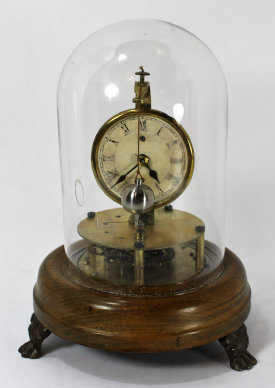
538. $190
Ansonia “Windsor”, ca. 1880. Ansonia made two mirror-sided shelf clocks, the Triumph and this
one, the Windsor. The black walnut case is 21.5 inches tall and 13 inches wide, slightly smaller than the Triumph. Both
are shown on pages 445 and 447 of Ly’s book on Ansonia clocks. This Windsor has a mirrored glass pendulum although the mirror
surface is oxidized behind the glass. The side mirrors are probably replacements; the door glass and the cupids are probably
original. The glass has lost much of its stenciled design from overzealous cleaning. Note the two front corner metal feet. The signed 8-day time-and-half-hour strike movement is running and keeping time. This clock also has an alarm which we did not
test; there is no label to be found. The glossy paper dial shows some foxing. A Windsor sold on eBay this year for $228. $200-$250.
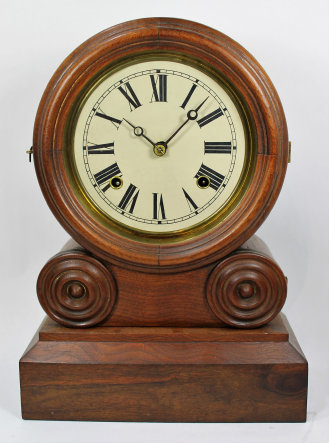
539. $150
Ingraham “Grecian”, ca. 1869. The ever-popular Grecian, a 14.25-inch walnut case with rosewood
veneer, a new paper dial in a brass bezel, old glass and appropriate hands. The finish is very good. The 8-day time-and-strike
signed movement is running, striking a wire gong and keeping time. Good green label inside. $150-$250.

540. $60
Welch, Spring & Co. “Cottage Column”, ca. 1880. This 30-hour cottage is 14 inches tall with
rosewood veneer in need of a light cleaning, a repainted metal dial, appropriate hands, and two old glasses. The columns are
gilt over gesso, with most of the gilt lost. A good label inside. The signed movement is running and striking. $75-$150.

541. $75
New Haven “Los Barrios”, 1913. A Mission-style clock from New Haven in solid oak with
a “Flemish finish”, 13.5 inches high. This is a nice size shelf clock with a nice finish, not too dark. If you like the
Arts and Crafts movement and a rustic look these clocks are great, and this is one of the nicer ones. This model line featured
brass numerals and hands, fancy exposed hinges and a lift-latch to open the door. It holds an 8-day time-and-half-hour strike,
signed movement that is running but only for a short while and needs service. There is a label on the back but it is too dark
to read. The clock is shown on page 353 of Ly’s book on New Haven clocks. I’m not a big fan of Mission clocks, but I like
this one. $75-$150.
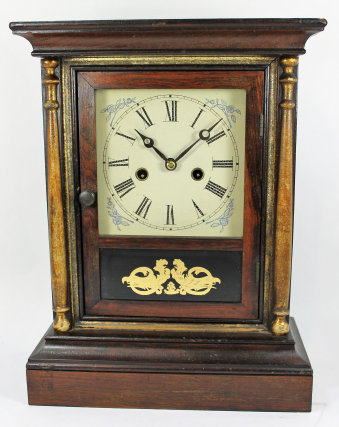
542. $350
Forestville Manufacturing Co. triple-decker shelf clock, 1835-1839. The label on the backboard
indicates that this clock case was made in the late 1830’s by the first incarnation of the Forestville company with Brown, Goodrich,
Waters, Boardman and Hills. The signed movement was probably made later in this company’s history. It is running but the
strike is stuck and will need some attention. There is a wooden dial board, appropriate hands and three old glasses, two of
which hold original tablets. The glasses are probably replacements in this clock based on the strips holding them in place. The label is very dark; there is a very old pendulum bob and two modern replacement weights. The mahogany veneer is in good
shape with losses along the edges at the top sides and bottom sides. Overall an excellent example with the two glasses. $350-$500.
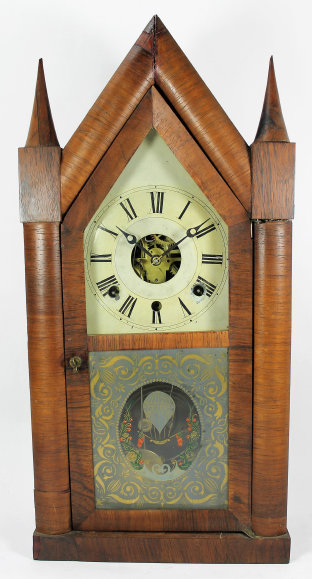
543. $160
Chauncey Boardman fusee steeple, 1847-1850. Boardman with Joseph Wells received a patent in
1847 on a “reversed fusee” movement in which the spring and fusee are mounted on the same shaft, as found here and imprinted on the
signed movement. They broke up their partnership in 1844 and produced clocks independently; Boardman died in 1857. This
30-hour movement originally had an alarm but the mechanism has been removed. The green label is very dark but “Chauncey Boardman”
is visible under the right lighting. The painted dial is likely original and has been touched up; both glasses are very old,
the tablet showing a balloon with American flags on either side. The veneer on the 20-inch case is good, with a repair or two;
some veneer is missing at the peak. The clock is running and striking. Fusee steeples by this maker routinely sell on
eBay in the mid-$200’s. $200-$300.
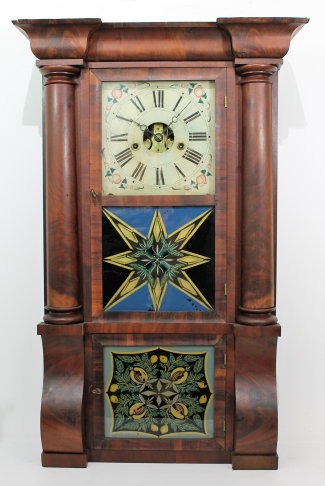
544. $160
Chauncey Jerome fusee steeple, 1845-1855. Jerome operated out of New Haven (as stamped on this
signed movement) during the indicated period. The dark green label is difficult to read but “Chauncey Jerome | New Haven” can
be seen at the bottom. Both glasses are old, and probably original; the numbering on the painted metal dial has been strengthened,
the hands look original. The veneer on this 19.5-inch case is very nice, with no obvious repairs or chips, and both cone finials
look good. There is a large vertical split in the backboard. We could not keep this one running for more than a few minutes
but oiling the back pivots would probably help. It looks like this is an 8-day clock. Jerome fusee steeples bring about
$400 on eBay. $200-$400.
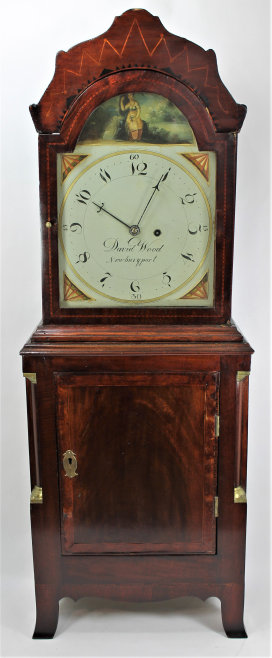
545. $6500
David Wood Massachusetts Shelf Clock, ca. 1810. David Wood is a highly regarded clockmaker
from Newburyport MA who apprenticed under Jonathan Mullikan or Daniel Balch, both of Newburyport; he made tall cases, banjos, and
Massachusetts shelf clocks. There are a number of examples of his work that have sold at recent auctions at widely varying prices;
one similar to this one sold for $17,000 in 2016. Foster Campos made a David Wood reproduction clock. This timepiece stands
33 inches tall and 12 inches wide at the feet. It appears to be a mahogany veneer over poplar or pine, with a fine boxed inlay
around the base and dial door, with additional detail painted on around the bottom door and the crest. The very nice painted
metal dial appears to be the original issue and the dial glass is old, as is the lead weight. The brass 8-day movement is running
and keeping time. Two very nice original Mass shelf clocks in this auction, something we don’t normally see. $7000-$10,000.
